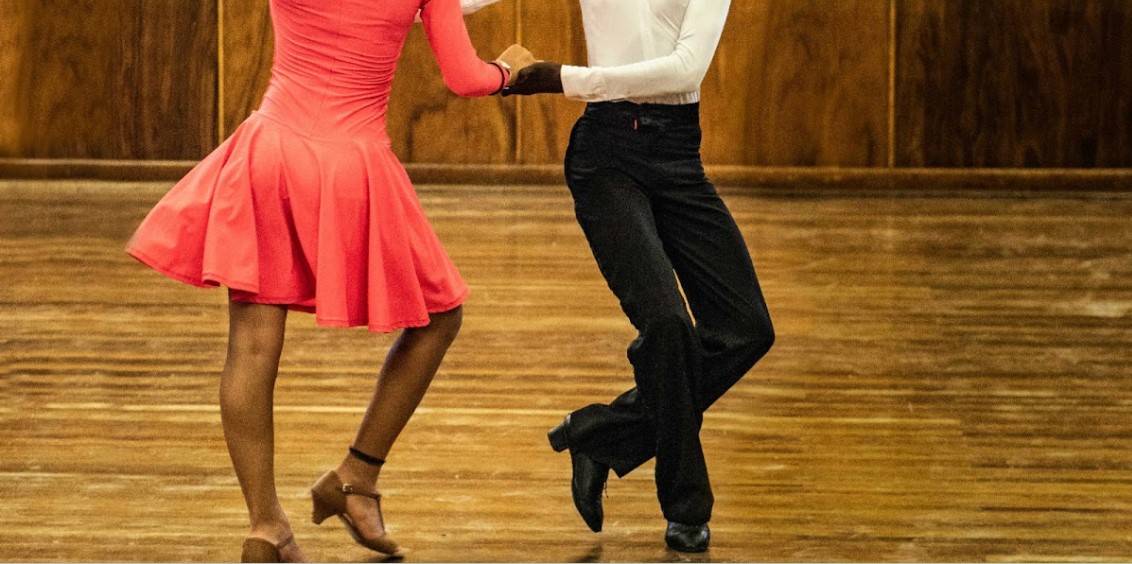Shoes
Some students have danced in casual shoes, had fun, and stayed safe. Still, both for fun and safety, I recommend getting shoes intended for dance – not necessarily by the first class.
The ideal footwear depends on:
— the dance
— the floor – and the humidity
— the person.
You might choose, sooner or later, to get more than one pair of dance shoes – perhaps specializing for different contexts.
Suede – In general, ideal dance shoes have a suede sole. Suede tends to provide a perfect balance of slip and grip – making it easy to pivot, glide, and possibly slide – without actually slipping. Don’t wear suede outdoors or on rough surfaces.

Leather – is generally a good runner-up to suede. It’s not good on vinyl floors in humid rooms, but if there’s air conditioning, or it’s winter, no problem.
[Time out. Is the text appearing centered to you? Not intentional. In fact it appears normal in the editing page. I can’t find why it displays centered. I just want you to know I’m aware it may be awkward to read, and I didn’t do it on purpose.]
Rubber – most rubber soles have too much grip. And yet: Keds – sneakers with rubber soles – were very popular among swing dancers for at least two decades. Keds have pockets of air under the soles, but the soles are quite flat.
Shoes designed for walking or running tend to aim for slip-resistance – they might have what I will call (lacking the proper word) gnarly carbunkles – made of rubber. Not good for most dance.
Also: most black rubber (natural and synthetic) marks some floors. Non-marking rubber soles do exist, usually with “non-marking” in the product specs.

You can convert existing dress shoes or casual shoes or athletic shoes into dance shoes. Perfect Shoe Repair at Orangeville Mall (a small storefront next to Pet Smart) does great work, and the owner used to be a dancer. Whether you go there or elsewhere, tell them you need the new soles to be adhered with glue (or contact cement), not nails, because they are for dance. Some soles are attached with nails, which is okay on parking lots and shopping malls, but when the sole wears down, the nail can scratch a dance floor.
If you want to dance in socks – join the club! I wouldn’t do that in a nightclub, but in the right environment, socks feel great to me.
Change Shoes – There are chairs. You can change your shoes in the room.
That might be all you need to read. I don’t want to overwhelm you. … It could however be good to read the following too:
Duct Tape!? An international competitor’s luggage was lost at the airport. He put duct tape on his running shoes, and came 3rd. Gaffer’s tape is better – made of cloth. (Trivia: Gaffers are head lighting electricians on film sets.) I have used duct tape. (Some people say duct tape increases grip, not slide, but that’s relative to the shoes you’re starting with.) I mention this as an option if you only have shoes with lots of traction. I will bring some to class.
Heel material is less important than the sole material, because most pivoting is done on the ball of the foot. Heels ideally have more friction / traction than under the ball of the foot. As above, they should be non-marking.
Heel shape: No stiletto heels, please. Flared heels might be okay (thin in the middle, wide at the base), but I recommend heels that don’t go thin.
Heel height: For beginners at least, I mostly want to say “don’t worry about it – wear what feels right to you” – including no heel. Swing and blues dancers rarely have heel height beyond pedestrian wear. For Texas Two-Step and Line Dancing, you could wear cowboy boots with heels (no spurs!) – but basic flats are great. For Ballroom and Latin, if you will be dancing primarily as a “follow”, 1.5″ to 2″ is recommended for beginners. (1″ is fine.) If you will be dancing primarily as a “lead”, 1″ is standard for Ballroom and 1.5″ for Latin, but 5/8ths of an inch feels right to me.
Split Sole – Most dance shoes have separation between the sole and the heel – just soft material, little or no structure. You can move your feet more easily when they don’t need to overcome a shoe structure.
(In high heels, that mobility has opposing effects – less exertion to overcome structure, but more exertion to “be” the structure. Also, some people benefit from having a degree of restraint on mobility. Increased stability is mostly good. Note that stability and mobility are not necessarily opposites. If you are more able to adapt to weight shifts and positions and other conditions, you are probably more stable. In that example, mobility and stability increase together.)
Barefoot? Not in the main class, but if you come to a more athletic class, for contemporary floorwork or contact improv or capoeira, barefoot is the way!
Alright – that was a lot of info. There is alas no clear definitive answer about what shoes to wear – but generally something that allows gliding and pivoting.

